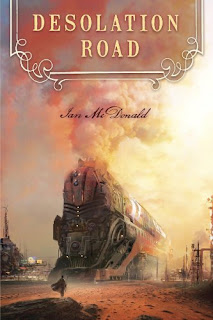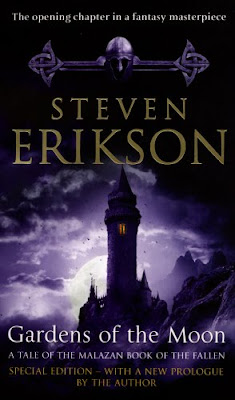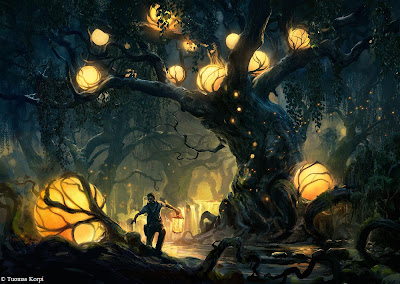
© The artwork presented on this post is used with the permission of its author. All the artwork is copyrighted. Please do not use the images without the permission of the artist or owner.
Tuomas Korpi is a Finnish artist, born on October 18th, 1985 and who currently lives in Espoo, Finland. He studied art at the Espoo School of Art and the Helsinki Upper Secondary School of Visual Arts and currently he is following the classes of Architecture at the Helsinki University of Technology.
Tuomas Korpi works as a freelance artist, but also with
Piñata and has experience in the computer games industry and marketing and advertising industry.
Interview with Tuomas Korpi
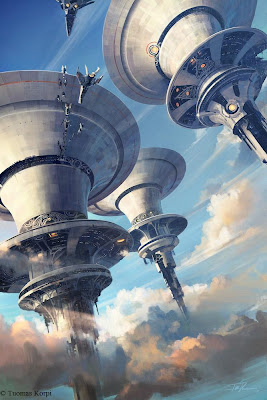
Mihai (Dark Wolf): Tuomas, thank you for the opportunity of this interview.
Which is your first recollection when it comes to art? Do you remember when you start drawing for the first time?
Tuomas Korpi: I don't have a first recollection but I do remember drawing at a very early age. Usually I drew on our kitchen table before going to bed or when I was visiting grandparents. They always gave me some pencils and pastels to play with since my grandma used to paint at the time. She also tried to give me some good advice about the colors I had picked but I remember my dad telling her not to criticize me all the time haha. I was like five years old or something.
Mihai (Dark Wolf): Who is your favorite artist? Who do you consider to have been the most influential figure on your art so far?
Tuomas Korpi: I have so many. But maybe the most influential artist for me is Finnish 19th century painter Albert Edelfelt. His style is really like a mixture of realism and impressionism with historical and Parisian themes. He was following the artistic movements in Paris at the time but did kind of his own thing, never went to impressionism all the way. Most of his paintings depict historical events and women but I really admire his way to paint Finnish nature - there his talent really speaks for itself. Amazing colors. There are also many other painters and concept artists I really like, but I think it was an Edelfelt painting that really spoke to me the first time.
Mihai (Dark Wolf): What other influences did you have in your working experience so far?
Tuomas Korpi: I try to follow everything that's happening in the vfx industry and what other artists are doing. Meaning watching the newest cg effect spectacles, advertisements, music videos, visiting forums and that sort of stuff. I guess it all influences my work somehow. I've also had the opportunity to work with some of the most talented retouch and 3d artists, designers and animators in Finland, it's all been a very influential and useful experience. At the studio we criticize each other’s work all the time so you get to hear a lot of different opinions. Very educational.

M(DW): Do you prefer to work with a specific tool, I mean do you prefer the traditional tools or the digital ones?
TK: Both. I usually do the early rough sketches traditionally and then move on to digital at some point. With real inks you get this certain level of looseness and roughness that is hard to achieve digitally. You don't have the undo button there, I guess that's what it's all about ;)
M(DW): Many pieces from your portfolio have Science Fiction themes. Does the Science Fiction genre influence your work? Do you have an interest in this genre beside art?
TK: I have to admit that I'm not very familiar with the genre. Yeah I've watched the regular Star Wars, Blade Runner and Alien movies and some Star Trek episodes but that's mostly it. Most of my sci-fi influences are from painters like John Berkey and Stephan Martiniere or from video games. I enjoy watching good sci-fi movie or read a book every now and then but it's not something I do every week.
M(DW): Also many of your art pieces have historical themes. Are you interested in history as well? Do you enjoy this type of paintings more?
TK: Very interested. I find different cultures very interesting and visiting historical sites or looking at historical paintings gets me carried away for a moment quite often heh. I have no any favorite periods, but I'm somehow drawn to South America and North-East Asia. I don't necessary enjoy these "historical" themes more, I think I always find the painting I'm working on at the very moment the most interesting and enjoyable for me… until I start working on something else.

M(DW): Does the historical works require a deeper documentation for the details (I mean for clothing, weapons, etc.) or there is room for improvisation as well?
TK: Usually the more history oriented paintings I'm painting have some sort of a fantasy twist in them, so there's always room for some improvisation. But I love adding details and making things look "right", so if there's some documentation, reference images or information available, I try to make it as accurate as possible. That's part of the fun!
M(DW): You worked on many advertising projects. Can you tell me please how was working in the advertising field? Do you consider that the freedom of creation in this domain is more restricted than in other domains which use art?
TK: I would say that the freedom is more restricted yes. It depends a lot, but generally speaking the inquiries I get are already very thought-through. There's always a change to suggest new ideas or improve the concept, but most of the time they are minor artistic things like lighting, colors, camera angles/perspective and things like that. Sometimes there's only a rough idea and you get to be responsible for the whole visual and how it's going to be presented, but in my job it's quite basic things most of the time.
And I like it. With advertising I have no interest in thinking about the brand strategy, how the concept of a new product should be presented or coming up with crazy visual ideas every week... I like my job as it is, dealing with the artistic side of things only. When creating concept art for movies or game companies it's different, there I'm working mostly on visual ideas for one project at a time and I want to be involved more even in the designing and ideating process. It's a different freedom for creation compared to advertising.
M(DW): How do you try to improve your technique? Do you try new techniques or themes often or do you try to improve your already established works and technique?
TK: I try different techniques and mediums sometimes, but at the moment I'm quite stuck to traditional-digital-combo. For me pencils, inks and a computer are the best techniques to communicate my visual ideas. What I try to improve every day is my understanding of light, colors and the world around me. In my opinion it's kind of the most important thing to become an artist - be interested in the world around you. It's something that's just come natural to me and I don't have to think it too much, I've always been curious to watch what's happening around me.
An example. I'm taking a bus to work every day, takes 20 minutes. The time I almost always keep watching the trees, sun rising/setting, clouds, different colors and materials, textures, how the light is reflected from the grass to the concrete wall, or how the reflection on the water is changing depending on the alignment of the bus to the sea, things like that. Sometimes I take quick notes or snap a photo with my cell phone!
Basically I'm trying to learn something new every day and then bring it to life in my paintings. Actually most of the ideas for my paintings start on these bus rides, when I'm seeing something inspirational and I try to think of ways to emphasize the idea I have even more.

M(DW): Did you thought about some changes in your career? I mean trying new experiences in your line of work, for example gaming concept art, movie concept art or comics industry?
TK: I'm interested in all job opportunities as a freelancer and also through our animation and illustration studio Piñata. Personally I'd like to be involved with movies more in the future, but at the moment working in advertising is very educational for me technique and style wise. I get to do so many different things and learn.
I've already done some gaming concept art and even some work for movies, but it's definitely something I'd love to do more often. We also have very good resources at our company and it would be interesting to try combining the talent we have for movies and comics industry also. We've done some work for game companies and would like to do it more.
M(DW): From all of your works do you have one that is closer to your heart? Which one do you consider to be the best you made so far?
TK: The few last ones are always the best and the rest of the stuff is too old and crappy to even look at.
Seriously.
M(DW): What projects do you have for the near and the distant future?
TK: In the near future I am very much involved with Piñata, working and making it succeed in every way possible. In the more distant future I'd like to see myself having more free time to do my own projects, working like a three or four-day week and have more freedom to choose clients and projects to work with. I'm not at all that picky about the clients or projects, but free time is very important for me.
Tuomas, thank you very much for your time and answers. It has been a pleasure.

For a complete portfolio of Tuomas Korpi, please visit his website
tuomaskorpi.com.
© The artwork presented on this post is used with the permission of its author. All the artwork is copyrighted. Please do not use the images without the permission of the artist or owner.


























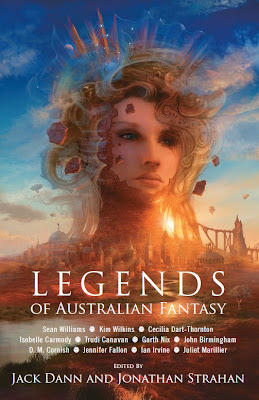
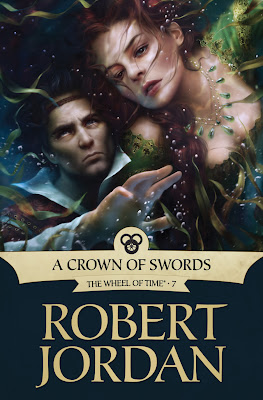

 Best Novel: “The City & The City” by China Miéville
Best Novel: “The City & The City” by China Miéville
